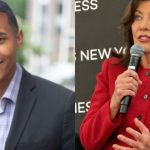Concerns about free speech undermining the equality and dignity of women helped usher in the now-fashionable equation between speech and violence, says famed civil liberties lawyer Nadine Strossen. Feminists have gone from arguing “that there is a causal connection” between discriminatory expression (a category in which many would include pornography) and violence to “denying that there is any distinction at all.”
I had the pleasure of interviewing her last week about Defending Pornography: Free Speech, Sex, and the Fight for Women’s Rights, her 1995 book that was reissued with a new preface last month, and why free speech is a cause that all feminists should support.
Now a professor at New York Law School and a senior fellow with the Foundation for Individual Rights and Expression (FIRE), Strossen headed up the American Civil Liberties Union (ACLU) from 1991 to 2008. She was also prominent in anti-censorship feminist action late last century, taking on the likes of Andrea Dworkin and Catharine MacKinnon over the legal status and cultural meaning of sexual expression.
You can read part one of our interview in last Monday’s Sex & Tech newsletter. Here’s part two.
Why do you think there’s been such a revival of these sorts of porn wars recently? Or did they never really go away?
Strossen: Throughout my lifetime and, much more importantly, I suspect throughout American history, sex and sexual expression have always been particularly feared and particularly demonized all across the ideological spectrum, albeit for somewhat different reasons. In Defending Pornography, at the beginning of the book, I cite some anthropologists and some cultural historians who comment on why that is, the puritanical heritage that we have in this country.
When it comes to controversial kinds of what the Supreme Court calls political speech, speech about public issues, we are more speech protective in many ways than countries that are otherwise comparable. We do protect so-called hate speech more than other countries, so-called extremism and disinformation. For all of the attacks on them here, they do continue to be protected in ways that they aren’t in other countries. Defamation, really strong criticism of public officials and public figures, is more strongly protected here. But in the realm of the sexual, we are the laughing stock of European countries and other comparable democracies because we continue to be so censorious. Even for all of the added speech protection that we’ve gotten from the Supreme Court in recent decades, we still have this completely court-created concept of illegal obscenity, which is completely excluded from any First Amendment protection at all. We continue to outlaw so-called “patently offensive” or “indecent” expressions on the broadcast media. I literally cannot say “fuck” on radio or TV when I’m describing the Supreme Court case in which that is a central word, the right to say “fuck the draft” during the Vietnam era.
I think it really never went away. It ebbs and flows and the particular factual context in which the suspicion towards sex changes somewhat. But, Liz, I would say a constant theme is very central to what we’re seeing now, which is the supposed danger, the assumed danger to children of any sexually-oriented expression.
You write about how porn doesn’t really have a concrete definition, and that allows people to twist it to being everything they don’t like—which, today, we see that with books and drag shows and anything having to do with queer culture. Is this something new or was this the case when you first wrote the book, too?
It was also the case when I wrote the book, and even earlier. I recall, from my own childhood, attacks on comic books and fears about even library books and bookstores. When I became older and read Supreme Court decisions, I could see that in the ’50s, the Supreme Court was striking down laws that were banning sexually oriented books of any sort—famous works, classic works of literature—from libraries and bookstores on the rationale that children would be damaged somehow by having access to these books or even seeing them in the windows of bookstores.
There was a famous case from [1948], Winters v. New York. Then there was another one in the early ’60s, the Ginsberg case, about so-called “girlie magazines” being sold in convenience stores. In all these cases, including in the most recent case in which the Supreme Court reaffirmed the completely court-manufactured obscenity exception—it’s an old decision that goes back to 1973, but the court hasn’t reexamined the issue since then. In every single case, the court assumes and presumes, acknowledging that there is no evidence, that sexual expression—when I say sexual expression, I mean just being exposed to it—necessarily has some dangerous consequences, especially for children. I think it’s very striking. The court says there’s no evidence but we can just take judicial notice. That means when something is so obvious that you don’t need evidence, like the sun rises in the East, and it’s just put on that plane, which would be completely unacceptable with respect to any other kind of speech. The government has the burden to show that it is actually harmful and that the only way to reduce the harm is through restricting the expression. It’s also just an unquestioned assumption that children in particular will be harmed.
Most recently where this has come up—some of the latest efforts where the Supreme Court considered laws that were restricting expression in various new media on the rationale of harm to children….When [the internet] first jumps onto the political and public radar screen and press radar screen, the very first impulse is to censor sexual expression, number one, for the sake of protecting children, number two. So the Communications Decency Act just sails through Congress [in 1996] with almost nobody on either side of the aisle voting against it.
The courts, to their credit, simply said, very explicitly: For the sake of resolving this case, we need not determine whether this expression actually is harmful to minors. We can simply assume that, for the sake of argument, because even if it were harmful to minors, this law would still be unconstitutional because it is not sufficiently narrowly tailored. You may not, for the sake of protecting minors, deprive adults of access to constitutionally protected material. That’s the line that the court has taken more recently, acknowledging that there is no evidence that kids are actually harmed, but they don’t reach issues that they don’t need to in order to resolve the case.
A couple of the judges, to their credit, have—in what we call dicta, because it’s not necessary to decide the case—gone the next step, including conservative Republican judges as well as liberal Democrat ones, saying, “By the way, we think that a lot of this expression, far from being harmful to minors, is actually helpful to them, maybe even life and health saving.” You know, information about LGBTQ sexuality, for kids who are living in very isolated communities where they don’t have any other access to communities and might be suicidal. Information about [sexually transmitted diseases] and preventing pregnancy is actually positive for minors.
You’ve talked about the ways a lot of these arguments have just been recycled over time. Have you seen anything new? Have you seen shifts in the arguments that people either on the left or the right have been making against pornography?
I haven’t. But in fairness, the arguments against censorship also haven’t changed. In some ways, each generation is kind of revisiting the issues over, and over and over again. Each side may believe that it is coming upon new insights just because they’re not aware of the history that preceded them.
To the best of my knowledge, what happened in the late ’70s, early ’80s with the advent of the MacKinnon-Dworkin so-called radical feminist approach together with the general concept of hate speech, I think that was the first time that there was a clear emphasis on equality concerns as being the greatest downside of whatever the controversial expression was. In the past the emphasis was more on concerns about the expression leading to crime and violence, undermining personal safety and national security. It’s not surprising that as our society and our legal system embraced a more robust concept of equality through the civil rights movement and the women’s movement, that that became a more persuasive counterforce, if you will, to freedom of expression. That started several decades ago. It’s relatively recent in our history, but I haven’t seen any big developments since then.
When I think of the latest attacks from the left, including many feminists, on sexual expression, they’re concerned about revenge pornography, so-called harassing, discriminatory harassment, the creation of a hostile environment, or divisiveness, or making people uncomfortable, or causing them to feel trauma—I think these are all specific examples of a general concern about protecting the equality and dignity of women.
One of the things I found really interesting that you write about is this idea of restricting speech on the rationale that it’s tantamount to illegal conduct. You write about how it’s a tactic that’s employed in all different areas, and especially in the realm of things such as abortion. Can you explain a little bit about how these sort of same arguments that justify censorship of pornography or of “obscenity” are also applied to reproductive freedom?
In my hate speech book, I have as an epigraph a quote from an early 20th century professor at Harvard Law School named Zechariah Chafee, who was one of the founders of the ACLU and one of the first theorists of free speech and advocates for free speech. He said, in the long run, every controversy about free speech comes down to this: How close a connection does there need to be between the expression and certain feared or disliked conduct to warrant government censorship of the expression?
What we see on the part of anti-abortion advocates as well as advocates against revenge porn, discrimination against women, harassment against women, and so forth, is a very broad concept of expression that could potentially lead to the conduct that they are seeking to prohibit. In the case of abortion, it’s any information about women’s bodies, and reproductive functions, and any information about the availability of abortion or contraception.
This goes back to the notorious Comstock Act, the Victorian era law that passed in 1873 and many people are surprised to learn is still on the books, and recently has been relied upon by certain government officials and by a federal judge in seeking to outlaw not only abortion itself, because the law outlaws obscene expression, it outlaws abortion and abortifacients—which was understood to mean anything that prevented conception—and also information about abortion and abortifacients or contraception.
I think that most recently, propelled by MacKinnon and Dworkin in the late ’70s and ’80s, there has actually been an equation between violence and discriminatory conduct and expression. That’s a new twist: Not making arguments that there is a causal connection, but they’re denying that there is any distinction at all.
Now, MacKinnon herself did write, repeatedly, that pornography is rape, and…to some extent, she was talking about the assertion that because no woman could actually consensually agree to perform for pornography, that necessarily any such performer was being raped. But she went beyond that to talk about even verbal descriptions without any actual performer, woman being involved, just a verbal description, is exactly the same.
There was an infamous situation where a book critic, a book reviewer for the Philadelphia newspaper, Carlin Romano, was doing a very critical review of one of MacKinnon’s books and in the review he does a thought experiment about MacKinnon herself being raped. I can’t remember what his exact argument was. But that led to attacks on him by MacKinnon and by her boyfriend at the time who literally accused him of raping her—I mean, for him to describe for purposes of making some philosophical argument, that they literally denied that there was any distinction between that and actual physical rape.
Now, at the time, I think the vast majority of us saw that as just kind of some kind of rhetorical hyperbole. But what’s happened in the meantime is we see students and faculty members, among many others…literally saying that there is no distinction between words and violence. That words are harm, words are violence. That’s a…sword that has two dangerous edges. Not only does it slay expression that is not in fact violent conduct that directly harms another person…but the other consequence of that approach is that violence is seen as justified to suppress words or expressions that you dislike.
In the latest survey that was done by FIRE and College Pulse of students’ attitudes toward violence, a shockingly high number agree that at least in some instances violence is justified to stop a speaker whose ideas you disagree with. I think it was something like only 30 percent of all students said that violence is never justified to stop somebody from conveying an idea that you find disagreeable or distasteful. Of the remaining 70 percent, some said it is often justified, and some said it is occasionally justified.
It’s interesting to trace that back to the arguments from MacKinnon and Dworkin. I hadn’t heard that before.
What’s so interesting is that it’s another example where there is such a disparity between what the law is and what the cultural perception is, in that the cultural perception—or misperception—can actually be more influential. Which is part of the reason why I spend so much time crusading, or evangelizing as I call it, because even though we have very speech-protective law—you know, it’s not 100 percent perfect but it’s really stronger than it’s ever been, with very solid support from very ideologically diverse justices—free speech is suffering because of the adverse cultural and social misperceptions that are prevalent, especially in so many institutions where it’s traditionally been cherished, including academia.
Do you see any reasons for optimism, either in the culture of free speech or in the legal battles surrounding it right now?
Yes, I do. The pendulum is always swinging and a reflection of how dire the situation has gotten is that there has been a lot of pushback, as people who I think are basically supportive of free speech didn’t understand how endangered it was. Development after development has persuaded more and more people that it really is a fragile, vulnerable situation.
Among other indications of this phenomenon, this pattern that I’m describing, we’ve seen a spontaneous creation of free speech organizations on campuses among students, among faculty members, among alumni and free speech initiatives that are being supported by university presidents and faculty administrators, as well.
Because in some ways this movement began in academia, including the feminist anti-pornography movement that grew out of a seminar that MacKinnon and Dworkin were teaching at the University of Minnesota Law School.
I just read today that it’s the third anniversary of the Academic Freedom Alliance, a nonpartisan group of ideologically diverse faculty members who are pledged to stand up for the free speech rights of any faculty member whose academic freedom is being jeopardized, even if we thoroughly disagree with the particular perspectives or ideas that are being aired by that faculty member. We’ve come to the defense, for example, of such a controversial figure as [law professor] Amy Wax…That’s a new organization. Heterodox Academy is a few years older, but that’s also a very important development, which is really growing very rapidly. I spoke to its president today, coincidentally, and he mentioned that they have a new faculty network—that in addition to the national organization, chapters are spontaneously forming on campuses all over the country.
Most heartening to me is—because I think the cultural change really has to come from the grassroots and in the case of academia, that means students as well as the leadership—most heartening are the flourishing of student organizations in favor of free speech, and that’s where a lot of my speaking is occurring. I’m being invited by these fairly new student organizations that are interested in learning about free speech, creating opportunities for free speech and for civil discourse on their campuses, and they’re ideologically diverse. These are students who are hungering for open discourse and dialogue.
Another example of a new institution is the University of Austin, a whole new university that’s trying to provide a counter and hopefully a model to spur the universities to actually live up to their truth-seeking missions in a way that they have not.
Reading Defending Pornography, there’s just so much that is relevant today—which is what I think every time I read books written in the 1990s by feminists. It’s just like, wow, we’re still having these same battles. But I want to ask you, why would you say that people should read this book now, in 2024?
First of all, I wish that I didn’t have to make this recommendation. I wish that the points that the book made are so self-evidently clear that it would be a waste of people’s time to read the book.
But what the book does make clear, I think, are the eternal debates that are simply being recycled—and recycled with a vengeance as we speak—about supposedly dangerous speech supposedly undermining, in particular, equal and full human rights for traditionally marginalized groups including women and feminists and advocates of our rights, and LGBTQ+ individuals and advocates of their rights, and reproductive freedom. The book makes clear that all of those rights, all of those groups, are especially dependent on a robust concept of freedom of speech that extends to sexually explicit speech.
The Supreme Court has always said that speech about public matters is at the apex of First Amendment values. Mystifyingly, it has always treated sexual expression as at the bottom of the hierarchy of free speech values. The reason I say it’s mystifying is because there is no distinction between those two categories. Think of all the vastly important public policy issues that turn on matters of sexuality, including sexual harassment, including abortion, including LGBTQ etc. rights. If you care about those rights and recognize how endangered they all are, it becomes especially important for you to understand that defending freedom for so-called pornography is an essential underpinning of those rights.
This interview has been condensed and edited for style and clarity.
More Sex & Tech News
• The Free Speech Coalition’s Mike Stabile dissects a particularly bad age verification bill that’s moving forward in Tennessee. Under the measure, which passed the state’s Senate Finance Committee on Tuesday, verification on adult sites would be required every 60 minutes.
• Rep. Ann Wagner “is obsessed with fearmongering about sex work.” Her latest target is OnlyFans.
Today’s Image
Las Vegas | 2016 (ENB/Reason)
The post <em>Defending Pornography</em> in the Age of Safe Spaces: A Q&A With Nadine Strossen appeared first on Reason.com.







